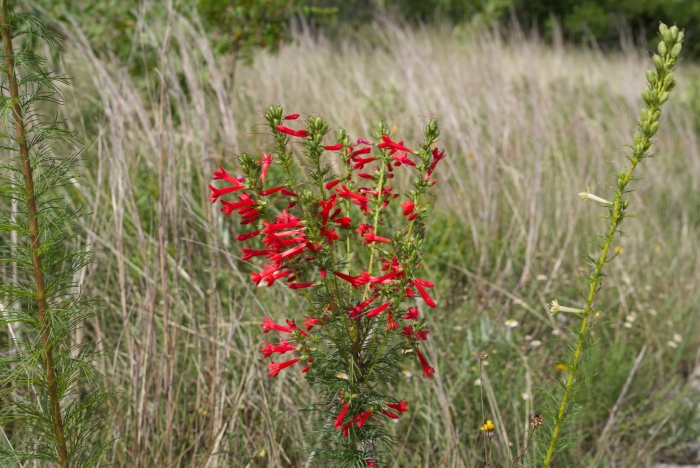Standing-Cypress
(Ipomopsis rubra)
Standing-Cypress (Ipomopsis rubra)
/
/

Michelle W.
CC BY 4.0
Image By:
Michelle W.
Recorded By:
Copyright:
CC BY 4.0
Copyright Notice:
Photo by: Michelle W. | License Type: CC BY 4.0 | License URL: http://creativecommons.org/licenses/by/4.0/ | Rights Holder: Michelle W. | Publisher: iNaturalist | Date Created: 2019-06-15T16:22:06-07:00 |
















































Estimated Native Range
Summary
Ipomopsis rubra, commonly known as Standing-Cypress, is a biennial herb that is often evergreen or semi-deciduous, native to open woodlands and prairies in the Southern United States. It typically grows to a height of 2-5 feet (0.6-1.5 meters) and a width of 2 feet (0.6 meters). The plant has a slender, upright form and produces showy, tubular flowers that are red with yellow throats, blooming in the summer months. These flowers are particularly attractive to hummingbirds and beneficial insects.
Standing-Cypress is valued for its striking floral display and its ability to attract wildlife. It is used in wildflower gardens, as a border plant, and in naturalized areas. It is well-suited to xeriscaping due to its low water requirements and is capable of self-seeding, which allows it to naturalize in suitable conditions. The plant prefers full sun exposure and thrives in well-drained soils. While it has a long taproot that helps it withstand drought, it can be difficult to transplant because of this feature. Gardeners should be aware that although it is generally pest-free, it can be susceptible to rust and fungal diseases in humid conditions.CC BY-SA 4.0
Standing-Cypress is valued for its striking floral display and its ability to attract wildlife. It is used in wildflower gardens, as a border plant, and in naturalized areas. It is well-suited to xeriscaping due to its low water requirements and is capable of self-seeding, which allows it to naturalize in suitable conditions. The plant prefers full sun exposure and thrives in well-drained soils. While it has a long taproot that helps it withstand drought, it can be difficult to transplant because of this feature. Gardeners should be aware that although it is generally pest-free, it can be susceptible to rust and fungal diseases in humid conditions.CC BY-SA 4.0
Plant Description
- Plant Type: Herb
- Height: 2-5 feet
- Width: 1.5-2 feet
- Growth Rate: Moderate
- Flower Color: Red
- Flowering Season: Summer
- Leaf Retention: Deciduous
Growth Requirements
- Sun: Full Sun
- Water: Low, Medium
- Drainage: Fast, Medium
Common Uses
Bee Garden, Bird Garden, Butterfly Garden, Deer Resistant, Drought Tolerant, Hummingbird Garden, Low Maintenance, Rock Garden, Showy Flowers
Natural Habitat
Native to open woodlands and prairies in the Southern United States
Other Names
Common Names: Scarlet Gilia , Texas Plume , Flame Flower , Indian Spur , Skyrocket , Praktgilia
Scientific Names: Ipomopsis rubra , Cantua pinnatifida , Gilia rubra , Gilia coronopifolia , Cantua coronopifolia , Polemonium rubrum , Cantua elegans , Cantua floridana , Cantua rubra , Cantua thyrsoidea
GBIF Accepted Name: Ipomopsis rubra (L.) Wherry